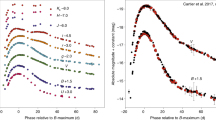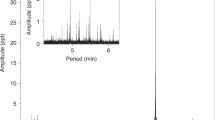Abstract
There is wide agreement that type Ia supernovae (used as standard candles for cosmology) are associated with the thermonuclear explosions of white dwarf stars1,2. The nuclear runaway that leads to the explosion could start in a white dwarf gradually accumulating matter from a companion star until it reaches the Chandrasekhar limit3, or could be triggered by the merger of two white dwarfs in a compact binary system4,5. The X-ray signatures of these two possible paths are very different. Whereas no strong electromagnetic emission is expected in the merger scenario until shortly before the supernova, the white dwarf accreting material from the normal star becomes a source of copious X-rays for about 107 years before the explosion. This offers a means of determining which path dominates. Here we report that the observed X-ray flux from six nearby elliptical galaxies and galaxy bulges is a factor of ∼30–50 less than predicted in the accretion scenario, based upon an estimate of the supernova rate from their K-band luminosities. We conclude that no more than about five per cent of type Ia supernovae in early-type galaxies can be produced by white dwarfs in accreting binary systems, unless their progenitors are much younger than the bulk of the stellar population in these galaxies, or explosions of sub-Chandrasekhar white dwarfs make a significant contribution to the supernova rate.
This is a preview of subscription content, access via your institution
Access options
Subscribe to this journal
Receive 51 print issues and online access
$199.00 per year
only $3.90 per issue
Buy this article
- Purchase on Springer Link
- Instant access to full article PDF
Prices may be subject to local taxes which are calculated during checkout
Similar content being viewed by others
References
Hillebrandt, W. & Niemeyer, J. C. Type Ia supernova explosion models. Annu. Rev. Astron. Astrophys. 38, 191–230 (2000)
Livio, M. in Type Ia Supernovae, Theory and Cosmology (eds Niemeyer, J. C. & Truran, J. W.) 33 (Cambridge University Press, 2000)
Whelan, J. & Iben, I. Binaries and supernovae of type I. Astrophys. J. 186, 1007–1014 (1973)
Iben, I. & Tutukov, A. V. Supernovae of type I as end products of the evolution of binaries with components of moderate initial mass (M not greater than about 9 solar masses). Astrophys. J. 54 (Suppl.). 335–372 (1984)
Webbink, R. Double white dwarfs as progenitors of R Coronae Borealis stars and type I supernovae. Astrophys. J. 277, 355–360 (1984)
Weidemann, W. Revision of the initial-to-final mass relation. Astron. Astrophys. 363, 647–656 (2000)
Hoeflich, P. & Khokhlov, A. Explosion models for type Ia supernovae: a comparison with observed light curves, distances, H 0, and q 0 . Astrophys. J. 457, 500–528 (1996)
Nugent, P., Baron, E., Branch, D., Fisher, A. & Hauschildt, P. H. Synthetic spectra of hydrodynamic models of type Ia supernovae. Astrophys. J. 485, 812–819 (1997)
Fink, M., Hillebrandt, W. & Röpke, F. K. Double-detonation supernovae of sub-Chandrasekhar mass white dwarfs. Astron. Astrophys. 476, 1133–1143 (2007)
Nomoto, K., Saio, H., Kato, M. & Hachisu, I. Thermal stability of white dwarfs accreting hydrogen-rich matter and progenitors of type Ia supernovae. Astrophys. J. 663, 1269–1276 (2007)
Yaron, O., Prialnik, D., Shara, M. M. & Kovetz, A. An extended grid of nova models. II. The parameter space of nova outbursts. Astrophys. J. 623, 398–410 (2005)
Panei, J. A., Althaus, L. G. & Benvenuto, O. G. Mass-radius relations for white dwarf stars of different internal compositions. Astron. Astrophys. 353, 970–977 (2000)
Kahabka, P. & van den Heuvel, E. P. J. Luminous supersoft X-ray sources. Annu. Rev. Astron. Astrophys. 35, 69–100 (1997)
Mannucci, F. et al. The supernova rate per unit mass. Astron. Astrophys. 433, 807–814 (2005)
Di Stefano, R. et al. Supersoft X-ray sources in M31. I. A Chandra survey and an extension to quasi-soft sources. Astrophys. J. 610, 247–260 (2004)
Terlevich, I. A. & Forbes, D. A. A catalogue and analysis of local galaxy ages and metallicities. Mon. Not. R. Astron. Soc. 330, 547–562 (2002)
Gallagher, J. S. et al. Supernovae in early-type galaxies: directly connecting age and metallicity with type Ia luminosity. Astrophys. J. 685, 752–766 (2008)
Bogdán, Á. & Gilfanov, M. Unresolved emission and ionized gas in the bulge of M31. Mon. Not. R. Astron. Soc. 388, 56–66 (2008)
Hachisu, I., Kato, M. & Nomoto, K. A new model for progenitor systems of type Ia supernovae. Astrophys. J. 470, L97–L100 (1996)
Nomoto, K., Nariai, K. & Sugimoto, D. Rapid mass accretion onto white dwarfs and formation of an extended envelope. Publ. Astron. Soc. Jpn 31, 287–298 (1979)
Li, X.-D. & van den Heuvel, E. P. J. Evolution of white dwarf binaries: supersoft X-ray sources and progenitors of type Ia supernovae. Astron. Astrophys. 322, L9–L12 (1997)
Schawinski, K. How old are SN Ia progenitor systems? New observational constraints on the distribution of time delays from GALEX. Mon. Not. R. Astron. Soc. 397, 717–725 (2009)
Iben, I. & Tutukov, A. V. Helium-accreting degenerate dwarfs as presupernovae and scenarios for the ultrasoft X-ray sources. Astrophys. J. 431, 264–272 (1994)
Acknowledgements
We thank F. Meyer and H. Ritter for discussions of various aspects of mass transfer in binary systems and the role of the common envelope evolution and L. Yungelson for discussions on the type Ia supernovae progenitor problem in general. This research has made use of Chandra archival data, provided by the Chandra X-ray Center (CXC) in the application package CIAO. This research has also made use of data products from the Two Micron All Sky Survey, which is a joint project of the University of Massachusetts and the Infrared Processing and Analysis Center/California Institute of Technology, funded by NASA and the NSF. The Spitzer Space telescope is operated by the Jet Propulsion Laboratory, California Institute of Technology, under contract with NASA.
Author Contributions Both authors contributed equally to this Letter.
Author information
Authors and Affiliations
Corresponding author
Ethics declarations
Competing interests
The authors declare no competing financial interests.
Rights and permissions
About this article
Cite this article
Gilfanov, M., Bogdán, Á. An upper limit on the contribution of accreting white dwarfs to the type Ia supernova rate. Nature 463, 924–925 (2010). https://doi.org/10.1038/nature08685
Received:
Accepted:
Issue Date:
DOI: https://doi.org/10.1038/nature08685
This article is cited by
-
Astronomical Distance Determination in the Space Age
Space Science Reviews (2018)
-
No hot and luminous progenitor for Tycho’s supernova
Nature Astronomy (2017)
-
Cobalt-56 γ-ray emission lines from the type Ia supernova 2014J
Nature (2014)
-
UV emission lines in passively evolving galaxies can reveal the progenitors of type Ia supernovae
Astrophysics and Space Science (2014)
-
An absence of ex-companion stars in the type Ia supernova remnant SNR 0509−67.5
Nature (2012)
Comments
By submitting a comment you agree to abide by our Terms and Community Guidelines. If you find something abusive or that does not comply with our terms or guidelines please flag it as inappropriate.



